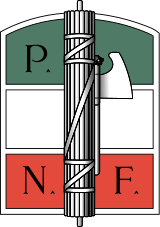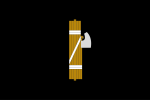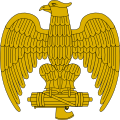الحزب الفاشي الوطني
National Fascist Party Partito Nazionale Fascista | |
|---|---|
 | |
| تاريخ التأسيس | 9 November 1921 |
| تاريخ الانحلال | 27 July 1943 |
| المقر الرئيسي | Palazzo della Farnesina Via della Lungara, 230 Rome, Italy |
| عدد الأعضاء | 6,000,000 (1939) |
| الأيديولوجية | Italian Fascism Ultranationalism Imperialism |
| الموقف السياسي | Far-right |
| علم الحزب |  |
| الشعار | "Credere, Obbedire, Combattere" ("Believe, Obey, Fight") |
| النشيد | Giovinezza |
| سياسة Italy | |
The National Fascist Party (Partito Nazionale Fascista, PNF) was an Italian political party, created by Benito Mussolini as the political expression of fascism (previously represented by groups known as Fasci). The party ruled Italy from 1922 when Fascists took power with the March on Rome, to 1943, when Mussolini was deposed by the Grand Council of Fascism.
Preceding the PNF, Mussolini's first established political party was known as the "Fascist Revolutionary Party" (Partito Fascista Rivoluzionario, PFR), which was, according to Mussolini, founded in 1915.[1] After poor November 1919 election results, the PFR was eventually renamed the National Fascist Party in November 1921 at the Third Fascist Congress in Rome.[2][3]
The National Fascist Party was rooted in Italian nationalism and the desire to restore and expand Italian territories, which Italian Fascists deemed necessary for a nation to assert its superiority and strength and to avoid succumbing to decay.[4] Italian Fascists claimed that modern Italy is the heir to ancient Rome and its legacy, and historically supported the creation of an Italian Empire to provide spazio vitale ("living space") for colonization by Italian settlers and to establish control over the Mediterranean Sea.[5]
Fascists promoted a corporatist economic system whereby employer and employee syndicates are linked together in associations to collectively represent the nation's economic producers and work alongside the state to set national economic policy.[6] This economic system intended to resolve class conflict through collaboration between the classes.[7]
Italian Fascism opposed liberalism, but rather than seeking a reactionary restoration of the pre-French Revolutionary world, which it considered to have been flawed, it had a forward-looking direction.[8] It was opposed to Marxist socialism because of its typical opposition to nationalism,[9] but was also opposed to the reactionary conservatism developed by Joseph de Maistre.[10] It believed the success of Italian nationalism required respect for tradition and a clear sense of a shared past among the Italian people alongside a commitment to a modernized Italy.[11]
The National Fascist Party along with its successor, the Republican Fascist Party, are the only parties whose re-formation is banned by the Constitution of Italy: "It shall be forbidden to reorganize, under any form whatsoever, the dissolved fascist party".
التاريخ

الأيديولوجيا
Secretaries of the PNF
- Michele Bianchi (November 1921 – January 1923)
- multiple presidency (January 1923 – October 1923)
- Triumvirate: Michele Bianchi, Nicola Sansanelli, Giuseppe Bastianini
- Francesco Giunta (October 15, 1923 – April 22, 1924)
- multiple presidency (April 23, 1924 – February 15, 1925)
- Quadrumvirate: Roberto Forges Davanzati, Cesare Rossi, Giovanni Marinelli, Alessandro Melchiorri
- Roberto Farinacci (February 15, 1925 – March 30, 1926)
- Augusto Turati (March 30, 1926 – October 7, 1930)
- Giovanni Giuriati (October 1930 – December 1931)
- Achille Starace (December 1931 – October 31, 1939)
- Ettore Muti (October 31, 1939 – October 30, 1940)
- Adelchi Serena (October 30, 1940 – December 26, 1941)
- Aldo Vidussoni (December 26, 1941 – April 19, 1943)
- Carlo Scorza (April 19, 1943 – July 27, 1943)
Election results
Italian Parliament
| Chamber of Deputies | |||||
| Election year | #of overall votes |
% of overall vote |
#of overall seats won |
+/– | Leader |
|---|---|---|---|---|---|
| 1924 | 4,653,488 (#1) | 64.9 | 375 / 535
|
Benito Mussolini | |
| 1929 | 8,517,838 (#1) | 98.4 | 400 / 400
|
▲ 25 | Benito Mussolini |
| 1934 | 10,043,875 (#1) | 99.8 | 400 / 400
|
Benito Mussolini | |
Party symbols
Slogans
- Il Duce! (The Leader!)
- Viva il Duce! (Long live the Leader!)[12]
- Eja, eja, alalà! (Equivalent to Hip, hip, hooray! in English)
- Viva la morte (Long live death [sacrifice])
- Credere, obbedire, combattere ("Believe, obey, fight")
- Vincere e vinceremo! ("Win and we will win!")
- Libro e moschetto - fascista perfetto (Book and rifle - perfect Fascist)
- Tutto nello Stato, niente al di fuori dello Stato, nulla contro lo Stato (Everything in the State, nothing outside the State, nothing against the State)
- Se avanzo, seguitemi. Se indietreggio, uccidetemi. Se muoio, vendicatemi (If I advance, follow me. If I retreat, kill me. If I die, avenge me)
- Me ne frego (I don't give a damn)
- La libertà non è diritto è un dovere (Liberty is not a right it is a duty)
- Noi tireremo diritto (literally We will go straight or We shall go forward)
- La guerra è per l'uomo, come la maternità è per la donna (War is to man, as motherhood is to woman)[13]
See also
== المراجع ==
- ^ Benito Mussolini (2006), My Autobiography with The Political and Social Doctrine of Fascism, Mineloa: NY: Dover Publication Inc., p. 227. Note that some authors refer to Mussolini's first political party as "The Revolutionary Fascist Party".
- ^ Charles F. Delzell, edit., Mediterranean Fascism 1919-1945, New York, NY, Walker and Company, 1971, p. 26
- ^ Joel Krieger, ed. (2012), The Oxford Companion to Comparative Politics, Oxford University Press, p. 120
- ^ Aristotle A. Kallis, Fascist ideology: territory and expansionism in Italy and Germany, 1922–1945. London, England, UK; New York City, USA: Routledge, 2000. Pp. 41.
- ^ Aristotle A. Kallis. Fascist ideology: territory and expansionism in Italy and Germany, 1922–1945. London, England, UK; New York City, USA: Routledge, 2000. Pp. 50.
- ^ Andrew Vincent. Modern Political Ideologies. Third edition. Malden, Massaschussetts, USA; Oxford, England, UK; West Sussex, England, UK: Blackwell Publishers Ltd., 2010. Pp. 160.
- ^ John Whittam. Fascist Italy. Manchester, England, UK; New York City, USA: Manchester University Press, 1995. Pp. 160.
- ^ Eugen Weber. The Western Tradition: From the Renaissance to the present. Heath, 1972. Pp. 791.
- ^ Stanislao G. Pugliese. Fascism, anti-fascism, and the resistance in Italy: 1919 to the present. Oxford, England, UK: Rowman & Littlefield Publishers, Inc., 2004. pp. 43–44.
- ^ Stanley G.Payne. A History of Fascism, 1914–45. Madison, Wisconsin, USA: University of Wisconsin Press, 1995. Pp. 214.
- ^ Claudia Lazzaro, Roger J. Crum. "Forging a Visible Fascist Nation: Strategies for Fusing the Past and Present" by Claudia Lazzaro, Donatello Among The Blackshirts: History And Modernity In The Visual Culture Of Fascist Italy. Ithaca, New York, USA: Cornell University Press, 2005. Pp. 13.
- ^ Smith, Denis M. Mussolini: A Biography. 1983. New York: Vintage Books. p176
- ^ Sarti, Roland. 1974. The Ax Within: Italian Fascism in Action. New York: New Viewpoints. p187.
وصلات خارجية
- THE DOCTRINE OF FASCISM / BENITO MUSSOLINI (1932)
- Fascist Italy and the Jews: Myth versus Reality an online lecture by Dr. Iael Nidam-Orvieto of Yad Vashem
قالب:Historical Italian political parties قالب:Italian Socialist Party
- Short description is different from Wikidata
- Articles with hatnote templates targeting a nonexistent page
- 1921 establishments in Italy
- 1943 disestablishments in Italy
- Anti-communism in Italy
- Anti-communist parties
- Fascist parties
- Italian Fascism
- Parties of one-party systems
- Political parties disestablished in 1943
- Political parties established in 1921
- Defunct political parties in Italy



